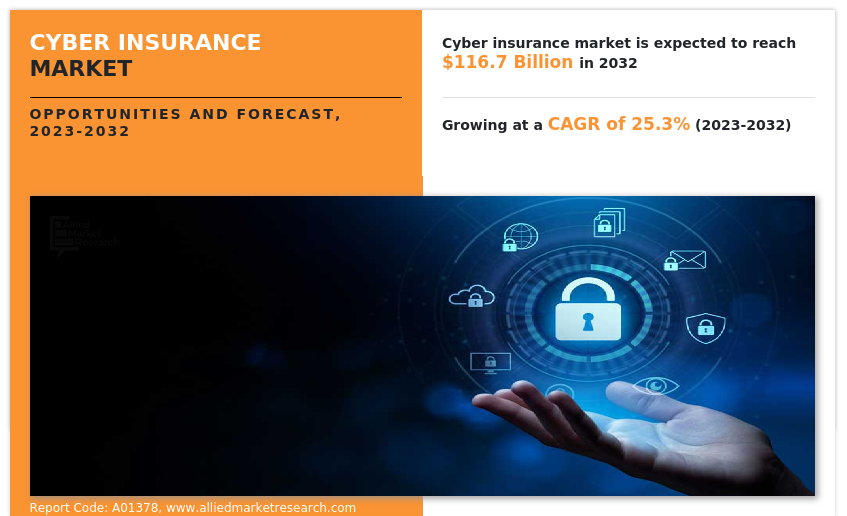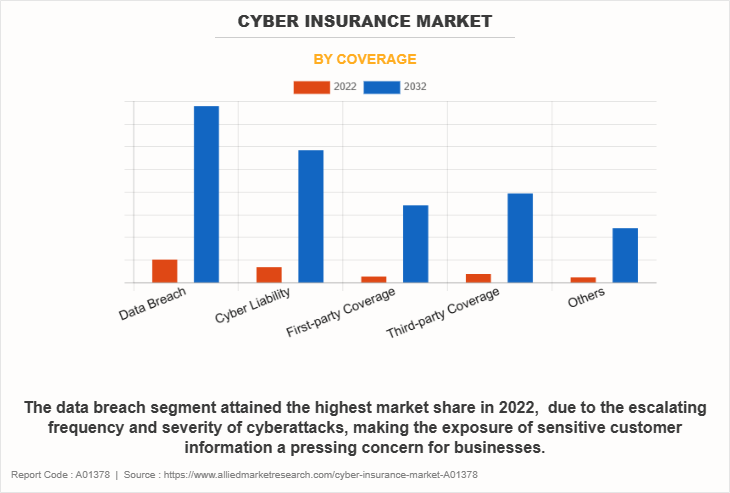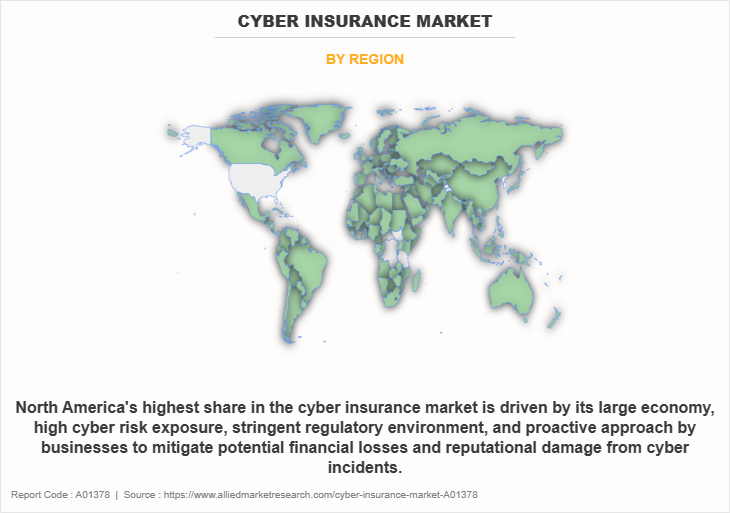Cyber Insurance Market Research, 2032
The cyber insurance market was valued at $12.5 billion in 2022, and is projected to reach $116.7 billion by 2032, growing at a CAGR of 25.3% from 2023 to 2032.
The cyber insurance market includes the coverage that provides protection against cost-associated with data breaches, credit monitoring, forensic investigations, reputation management, and business interruption. An in-depth analysis of cyber insurance premiums and their revenue across North America, Europe, Asia-Pacific, and LAMEA has also been included in the report. Growing awareness of cyber risks and expanded coverage offerings have propelled the demand for cyber insurance market, thereby driving the growth of the market. The cyber insurance providers are customizing coverages to a broader range of industries facing cyber-attacks and focuses on developing the products that address a variety of operational and privacy exposures in the cyber insurance market.

Furthermore, cyber insurance market refers to the sector or industry within the larger insurance industry that focuses on offering insurance coverage and risk management solutions to businesses and individuals to guard against financial losses and liabilities brought on by cyber-related risks, cyberattacks, and data breaches. This industry has developed in response to the expanding and constantly changing landscape of cyber threats as well as the rise in dependency on digital technology. In addition, many cyber insurance policies provide policyholders with access to incident response services, such as cybersecurity specialists, legal counsel, and forensic investigators, in the case of a cyber-incident. Moreover, as businesses become more aware of the need for security against cyber threats and data breaches, the market for cyber insurance market outlook has seen substantial expansion. The cyber insurance market forecast is still growing and adapting to meet the changing cyber risk environment.
The growth in cyber-attack is a significant driver of the growth of the cyber insurance market growth. Cyber threats are becoming more complicated and universal, affecting businesses of all sizes and in all sectors. A growing number of cyberattacks, such as ransomware, data breaches, and distributed denial of service (DDoS) assaults, has raised awareness of the importance of cyber insurance. Furthermore, rise in mandatory legislations regarding cyber security is driving the demand of the cyber insurance market size.
However, lack of standardization policies is hampering the growth of the cyber insurance carriers. Because there is a lack of consistency in how policies are designed, what they cover, and the particular terms and conditions as the cyber insurance market has developed to handle increasingly complex and diversified cyber risks. Both cyber insurers and policyholders have difficulties as a result of this lack of standardization. Moreover, high cost coverage are major factors that hamper the growth of cyber insurance market share. On the contrary, expansion of products and service is an opportunity for cyber insurance industry. Cyber insurers are able to provide a wider range of coverage alternatives due to an increase of products and services. Policyholders can choose coverage options that are better suited to their individual cyber risk profiles, industry-specific requirements, and financial limitations.
Cyber Insurance Market Segment Review
The cyber insurance market is segmented on the basis of coverage, enterprise size, industry vertical, and region. By coverage, the market is segmented into data breach, cyber liability, first-party coverage, third-party coverage, and others. By enterprise size, it is segmented into large enterprise, and small and medium-sized enterprise. On the basis of industry vertical, it is segmented into BFSI, IT and Telecommunication, retail and E-commerce, healthcare, manufacturing, government and public sector, and others. By region, it is analysed across North America, Europe, Asia-Pacific, and LAMEA.

On the basis of coverage, the data breach segment attained the highest share in 2022 in the cyber insurance market. This can be attributed to the fact that organizations now have legal responsibility to secure and handle sensitive data as a result of strict data protection laws such as, general data protection regulation (GDPR), and central consumer protecting authority (CCPA). Organizations can comply with these regulatory standards with the use of cyber insurance market policies that cover cyber breach insurance data. Meanwhile, the first-party coverage segment is projected to be the fastest-growing segment during the forecast period. This is attributed to the fact that first-party coverage shields the insured company from a variety of direct damages, including those associated with data breach notification, forensic investigations, business interruption, and data recovery. In order to reduce risks and guarantee their capacity to quickly recover from cyber events, businesses are actively looking for comprehensive first-party coverage due to the increasing complexity of cyber threats and their potential financial impact.

On the basis of region, North America attained the highest market share in 2022 and emerged as the leading region in the cyber insurance market. This is attributed to the fact that cyber risks and the value of cyber insurance market are well-known in North America, especially in the U.S. Organizations in the area have been initial users of cyber insurance market coverage to protect themselves against data breaches and cyber threats. On the other hand, the Asia-Pacific region is projected to be the fastest-growing region for the cyber insurance market during the forecast period. This market growth is attributed to the fact that Asia-Pacific has developing nations with growing economies. Due to the rapid adoption of technology, e-commerce, and digital services in Asia-Pacific countries such as China, India, Japan, and others, cyber insurance industry is becoming an essential component of risk management for businesses aiming to safeguard their digital assets.
The report focuses on growth prospects, restraints, and trends of the cyber insurance market forecast. The study provides Porter’s five forces analysis to understand the impact of various factors, such as bargaining power of suppliers, competitive intensity of competitors, threat of new entrants, threat of substitutes, and bargaining power of buyers, on the cyber insurance market.
Cyber Insurance Market Competition Analysis
Recent Product Launched in the Cyber Insurance Market
In September 2023, Onsurity launched cyber insurance for India’s SMEs and expanded its suite of products to help businesses mitigate risks. Onsurity Plus, the company, is interested in redefining business security for its customers by delivering a diverse variety of insurance solutions designed to reduce business and operational risks, reinforcing its commitment to supporting robust and flourishing business ecosystems. Furthermore, to provide this crucial product to businesses in India, Onsurity has partnered up with the top insurance providers in India and the biggest AA-rated reinsurers worldwide. The plan provides a full range of security features, including coverage for data breaches, ransomware attacks, business interruption, and legal costs associated with cyber disasters. This customized solution is intended to assist SMEs in reducing the financial and reputational risks connected to cybersecurity breaches.
Recent Partnership in the Cyber Insurance Market
In September 2023, Tech Mahindra, a leading provider of digital transformation, consulting, and business re-engineering services and solutions, has partnered with Surance, an innovative personal cyber insurance platform. Through this strategic agreement, the insurance industry has access to improved cybersecurity solutions and global, multinational technical assistance. Furthermore, through this partnership, Surance.io has been able to communicate with their international clients in more than 20 different languages and offer seamless services to create improved client experiences. With the help of best-in-class call centre services, cutting-edge AI-based threat detection systems, and specialized advice to stop cyberattacks, the alliance aims to protect insurance consumers in the cyber insurance platform.
Recent Product Launched in the Cyber Insurance
In July 2023, QBE North America launched a new cyber insurance program with Converge, a new MGA that act as the program administrator. This program is likely to provide businesses with tailored insurance solutions to address the increasing risks of cyber threats, data breaches, and related incidents. MGAs like Converge often play a pivotal role in designing and managing these programs, ensuring they meet the specific needs of policyholders. This initiative highlights the insurance industry's commitment to offering comprehensive and innovative cyber insurance options in response to the evolving digital risk landscape in the cyber insurance sector.
Top Impacting Factors
Growth in Cyber-attacks
Cyber threats have several implications on public safety, economic prosperity, and government security. To address these issues, governments of various nations have formed their respective cybersecurity commissions and task forces to mandate security practices. Furthermore, high-profile data breaches and cyber incidents have raised awareness about the potential financial and reputational consequences of cyberattacks. Businesses and organizations are increasingly recognizing the need to mitigate uncertainty risks with the help of cyber insurance. Moreover, Cyber threats are constantly changing, with new attack methods and strategies appearing frequently. Cyber insurance is a desirable risk management instrument because of the unpredictability brought on by this dynamic threat landscape. Furthermore, cyberattacks can disrupt business operations, leading to financial losses. Cyber insurance market outlook often covers business interruption, helping companies recover lost income during downtime caused by cyber incidents. Therefore, growth in cyber-attacks are increase the demand of the cyber insurance.
Rise in Mandatory Legislations Regarding Cyber Security
Cyber threats have several implications on public safety, economic prosperity, and government security. To address these issues, governments of various nations have formed their respective cybersecurity commissions and task forces, mandated security practices, and offered incentives to top cybersecurity industry. The countries in Asia-Pacific such as Singapore, Australia, South Korea, Taiwan, the Philippines, and Malaysia have also adopted new data privacy regulations. This approach for data protection by various governments to obligate rules and regulations are anticipated to increase the demand for cyber insurance. Furthermore, many countries and regions have enacted data protection laws, such as the European Union's General Data Protection Regulation (GDPR) and the California Consumer Privacy Act (CCPA). These laws require organizations to safeguard personal data and notify individuals and authorities in the event of data breaches. Compliance with these laws often necessitates cyber insurance coverage to mitigate the financial impact of non-compliance. In addition, mandatory breach notification regulations require enterprises to alert regulatory authorities and affected parties of data breaches within predetermined deadlines. Legal and communication costs, as well as other costs related to such notifications, must be covered by cyber insurance. Therefore, rise in mandatory legislations regarding cyber security are driving the cyber insurance market growth.
Lack of Standardized Polices
Cyber insurance policies are meant to cover losses incurred due to cyber-attacks and data & privacy security breaches. These policies are marketed under "privacy breach insurance", "cyber-liability insurance," and "network security insurance." Thus, lack of standardized policies limits the growth of the cyber insurance. The terms of policies vary from insurer to insurer thereby becoming complicated in nature. It is very difficult to manage these evolving cyber risks, due its increased frequency, complexity, and varying cyber-attack. This varying landscape has led to a new threat faced by insurers and reinsurers; and left several demand gaps in the industry and requires flexibility in cyber risk management tools. Furthermore, cyber insurance policies may differ in their level of coverage among different cyber insurance companies as a result of the lack of uniform terms and concepts. Organizations find it difficult to compare policies and completely learn the scope of coverage due to this lack of consistency. In addition, cyber insurance policies often contain complex and technical language. The lack of standardized language and terms can make it difficult for policyholders to fully comprehend the terms and conditions of their coverage, potentially leading to misunderstandings and disputes. Therefore, lack of standardized policies hampers the growth of cyber insurance market share .
Expansion of Products and Services
Cyber insurance has an immense potential as it is largely an untapped market. The companies are extending cyber liability to their supply chains, providing new opportunities for cyber insurance providers to innovate their insurance products in the market. Criminal organizations work with technology professionals to fund illegal activities such as theft or converting stolen data into money. In such a scenario, insurers can monitor external indicators in the cyber environment and manage the threat accordingly. Furthermore, businesses encounter a wide variety of cybersecurity hazards specific to their sector and offers with the launch of new products and services. Cyber Insurers have the chance to create customized plans provided to certain industries and developing risks due to the diversity of coverage needs. In addition, cyber insurers can innovate by creating new coverage choices that protect against developing risks in order to address evolving cyber threats. In particular, it is possible to include coverage for hazards related to Internet of Things (IoT) devices, cloud services, and artificial intelligence (AI). Therefore, expansion of products and services, and an increase in benefits of cyber insurance awareness are opportunities for cyber insurance market size.
Key Benefits for Stakeholders
- This report provides a quantitative analysis of the market segments, current trends, estimations, and dynamics of the cyber insurance market forecast from 2022 to 2032 to identify the prevailing cyber insurance market opportunity.
- The market research is offered along with information related to key drivers, restraints, and opportunities.
- Porter's five forces analysis highlights the potency of buyers and suppliers to enable stakeholders make profit-oriented business decisions and strengthen their supplier-buyer network.
- In-depth analysis of the cyber insurance market segmentation assists to determine the prevailing market opportunities.
- Major countries in each region are mapped according to their revenue contribution to the global market.
- Market player positioning facilitates benchmarking and provides a clear understanding of the present position of the market players.
- The report includes the cyber insurance market analysis of the regional as well as cyber insurance market trends, key players, market segments, application areas, and market growth strategies.
Cyber Insurance Market Report Highlights
| Aspects | Details |
| Market Size By 2032 | USD 116.7 billion |
| Growth Rate | CAGR of 25.3% |
| Forecast period | 2022 - 2032 |
| Report Pages | 432 |
| By Coverage |
|
| By Enterprise Size |
|
| By Industry Vertical |
|
| By Region |
|
| Key Market Players | Aon plc., Allianz, ZURICH, AXA SA, American International Group, Inc., Lockton Companies, Lloyd’s of London Ltd., Berkshire Hathaway, Munich Reinsurance Company., Chubb |
Analyst Review
Rise in cyber-attacks has led to organizations from all the major industries to focus on cyber coverage for liability and property exposure. A considerable number of companies still remained under the false perception of cyber risk exposure in the last few decades. However, this scenario has changed in the recent years and witnessed a significant growth in sale of cyber insurance policies, owing to rise in cyber risk awareness among C-level executives. Moreover, penetration of cyber insurance has increased among data-driven industries such as communication, finance, retail, and healthcare, which are considered more vulnerable to cyber-attacks. Most of these companies have implemented some pre-breach risk management activities to minimize the cyber risk exposure. In addition, cyber insurance is becoming more and more popular as companies in developing economies utilize digital technologies. There are chances for insurers to contact more people and offer coverage in such regions. Furthermore, technology and advanced data analytics present chances to enhance risk assessment procedures, enabling insurers to more precisely identify cyber threats and determine the right premiums.
Furthermore, market players have adopted various strategies for enhancing their services in the market and improving customer satisfaction. For instance, in June 2023, according to PR newswire, Zurich launched a cyber-insurance offering specifically tailored for middle-market businesses in North America. The product can help companies resolve both first-party cyber occurrences and third-party claims, adding value to other property or casualty coverages currently carried by Zurich.. Moreover, in March 2021, Munich Re has partnered with Google Cloud and Allianz to launch the innovative cyber insurance solution “Cloud Protection +” exclusively for Google Cloud customers. Munich Re has identified the coverage of cyber risks as a critical area of business where it wants to continue experiencing sustainable growth. Munich Re, one of the pioneers, was among the first to acknowledge the difficulties in cyber insurance. Munich Re maintains its position as one of the top providers by consistently improving its own strategy and risk modeling as well as working with clients and partners. Cyber threats and loss scenarios evolve swiftly and frequently. These strategies by the market players operating at a global and regional level is expected to help the market to grow significantly during the forecast period.
Some of the key players profiled in the report include Allianz, American International Group Inc., Aon plc, AXA, Bekshire Hathway Inc., Lloyd’s of London Ltd, Lockton Companies, Munich Re, The Chubb Corporation, and Zurich. These players have adopted various strategies to increase their market penetration and strengthen their position in the cyber insurance.
The cyber insurance market was valued at $12.5 billion in 2022 and is projected to reach $116.7 billion by 2032, growing at a CAGR of 25.3% from 2023 to 2032.
The cyber insurance market offers coverage protecting against costs associated with data breaches, credit monitoring, forensic investigations, reputation management, and business interruptions.
Major players in the cyber insurance market include Cowbell, which has partnered with Swiss Re to provide specialized cyber insurance programs.
While specific regional data for the cyber insurance market isn't provided, the broader cybersecurity market was dominated by North America in 2023, a trend likely reflective in the cyber insurance sector.
The market is driven by the increasing frequency of cyberattacks, growing awareness of cyber risks, and expanded coverage offerings tailored to various industries.
Challenges include a lack of standardized policies and the complexity of assessing and underwriting diverse cyber risks.
Loading Table Of Content...
Loading Research Methodology...


